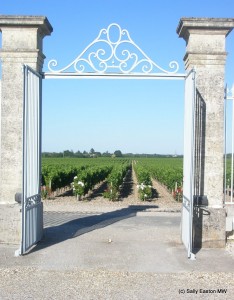Crus Bourgeois – a steady ship

Martine Cazeneuve, Château Paloumey
Having had just 18 months in 2007 to reinvent themselves, after the previous cru bourgeois system was cancelled, the Alliance des Crus Bourgois du Médoc consider themselves fortunate to have saved the name ‘cru bourgeois’ a term which has positive resonance with consumers. Jean Baptiste Cordonnier of Château Anthonic in Moulis-en-Médoc, said “Cru bourgeois had an image. It is a sign of recognition, for consumers looking for a high level of wine, an alternative to crus classes.”
Now, after three short years of the new incarnation of the cru bourgeois, the mood is a combined one of calm competence and a recognition that much work remains to be done to solidify the foundations and regain the respect of the markets.
One thing the new incarnation has achieved is the elimination of the bottom end of the historical, previous cru bourgeois. This is because a minimum quality standard has been introduced, and is judged in blind tastings each year. Martine Cazeneuve of Château Paloumey in Haut-Médoc, explained the process is expensive and “it’s a lot of work for a château to become cru bourgeois. It’s different from the past, there are no more cru bourgeois at €3 to €4. Today cru bourgeois prices in wine shops range from €8 to €25.” The cost and quality barrier to entry already makes this quite large heterogeneous group slightly more homogeneous by eliminating the bottom tranche.
Even so, this is quite a price range, and it’s one of the reasons a cru bourgeois hierarchy is being discussed. But there’s a lot of baggage associated with this idea after the collapse of the 2003 classification which had three rankings – exceptionnels, supérieurs, and straight cru bourgeois – but the idea looks like it will hold water in the coming years because 260-odd châteaux is a lot, and there are flavour and quality differences between one priced at €8 and one at €25. Cazeneuve said “all of us are not producing the same wine, of the same quality. It would be good to have a small differentiation in cru bourgeois, but not one taken from the past.” There’s clearly still a lot of sensitivity there.
One of the main advantages and challenges of the new cru bourgeois system is the annual blind tasting. It keeps producers on their toes and striving for better quality, but it’s an arduous, and time-constricted process. The tastings run from February to July. As it is, if there is time and a wine has failed the tasting, a property can re-submit their wine having tweaked it back at the ranch. But logistics can be difficult to rearrange, which may preclude a sample being resubmitted.

Château Paveil de Luze
Alternatively, if a producer wants to mature their wines in bulk for as long as possible, so submits samples late, there’s no margin for tweaking (in case of failure) because the judging sessions will end. This may mean time in barrel is a bit shorter than the owner would ideally like because the wine must be assembled for the tasting, so there is the potential for some of the winemaking needing to fit the schedule of taste sessions, which isn’t ideal, but lines have to be drawn somewhere.
It’s not just the properties for which this is a challenge. Frédéric de Luze, owner of Château Paveil de Luze in Margaux, and president of the Alliance des Crus Bourgeois du Médoc, said “the main problem is that you have to pass the exam every year – it’s difficult for negociants and importers because they don’t know if a château will be cru bourgeois the next year.”
He acknowledged “there are lots of things to improve. We have a few plans we’re working on, and we know this is one of the new improvements we may find”, potentially for consistently awarded properties not to have to submit samples for tasting every year.
One of big questions is whether an improving cru bourgeois category can hope to fill the gaping hole left by the crus classés as their prices reach stratospheric levels. Cazeneuve thinks so, as she said “behind the crus classes, which are expensive and out of reach, cru bourgeois has a place as both affordable and good value. And you can actually drink them, instead of just speculating, as for the top crus classés.” It’s a good point.
My research visit to Bordeaux was sponsored by the Alliance des Crus Bourgeois du Médoc.



